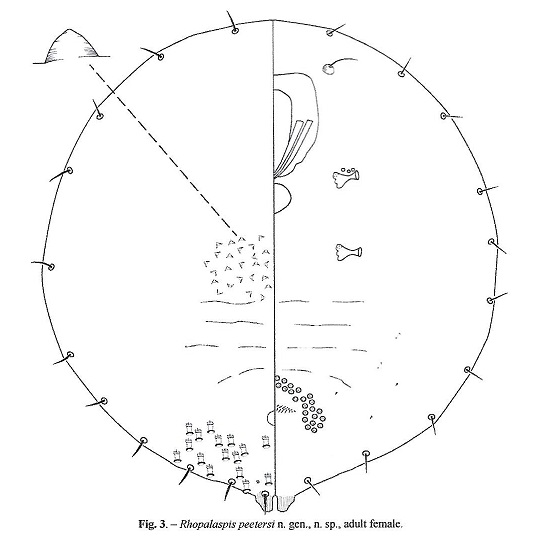Valid Names Results
Rhopalaspis peetersi Matile-Ferrero & Foldi, 2018 (Diaspididae: Rhopalaspis)Nomenclatural History
- Rhopalaspis peetersi Matile-Ferrero & Foldi 2018: 527. Type data: SINGAPORE: Mandai Road, GPS 1.41318 103.79405, on Aquilaria malaccensis (Thymelaeaceae), living into the nest of Rhopalomastix johorensis, 11/21/2016, by Yong & Chui.. Holotype, female, by original designation Type depository: Paris: Museum National d'Histoire naturelle, France; accepted valid name Notes: Paratypes: 21 adult females, slide mounted, some with crawlers inside, MNHN 19955-1 to 11 (11 slides). Same data as holotype, deposited in MNHN. Illustr.
Common Names
Ecological Associates
Hosts:
Families: 1 | Genera: 1
- Thymelaeaceae
- Aquilaria malaccensis | MatileFo2018
Associates:
Families: 1 | Genera: 1
- Formicidae
- Rhopalomastix johorensis | YongMaPe2019 | (= Rhopalomastix janeti)
- Rhopalomastix rothneyi | MatileFo2018 | subspecies: johorensis
Geographic Distribution
Countries: 1
- Singapore | MatileFo2018
Keys
Remarks
- Systematics: http://zoobank.org/6BE05470-57E0-46C4-A7AB-D12855832662 Rhopalaspis peetersi differs from other genera of the tribe Aspidiotini in the absence of plates and dorsal macropores on the pre-pygidial segments VI to I. The adult female is scale-less, unlike all the other species of free-living Diaspididae. It has a spherical body and consequently is difficult to mount on slide in the usual dorso-ventral position. The pygidial margin is hardly observable. The medio-dorsal minute tubercles are observed for the first time among the Diaspididae. They are not associated with pores and their function is unknown. (Matile-Ferrero & Foldi, 2018)
- Structure: Species scale-less. Living adult female spherical, purple (according to the collectors) but more yellowish when younger. Eggs, embryos and first instar nymphs observed. Male not observed. (Matile-Ferrero I& Foldi, 2018) Slide mounted adult female: 0,40-0,46 mm long; widest at metathorax, 0,35-0,45 mm wide. Body outline rounded, derm membranous. (Matile-Ferrero & Foldi, 2018) First instar nymph. – General aspect as all diaspidid species. Antennae 6-segmented, last segment as long as 2-5 combined, not annulated. Legs developed. Enlarged dorsal duct absent on head. Median lobes well-developed, sclerotized, with three external notches and long inner sclerotized paraphysis (fig. 2). Median space wide as a single lobe, with two long setae. (Matile-Ferrero & Foldi, 2018)
- Biology: Rhopalaspis peetersi lives in huge number in the galleries of the arboreal colony of Rhopalomastix rothneyi johorensis (Hymenoptera, Formicidae, Myrmicinae, Crematogastrini). No colonies of this species were observed on the aerial parts of the tree. (Matile-Ferrero & Foldi, 2018)
- General Remarks: Detailed description, photographs and illustration in Matile-Ferrero & Foldi, 2018
Illustrations
Citations
- MatileFo2018: ant association, description, distribution, host, illustration, taxonomy, 525-529
- WilliaDe2020: taxonomy, 199
- YongMaPe2019: ant association, 3



